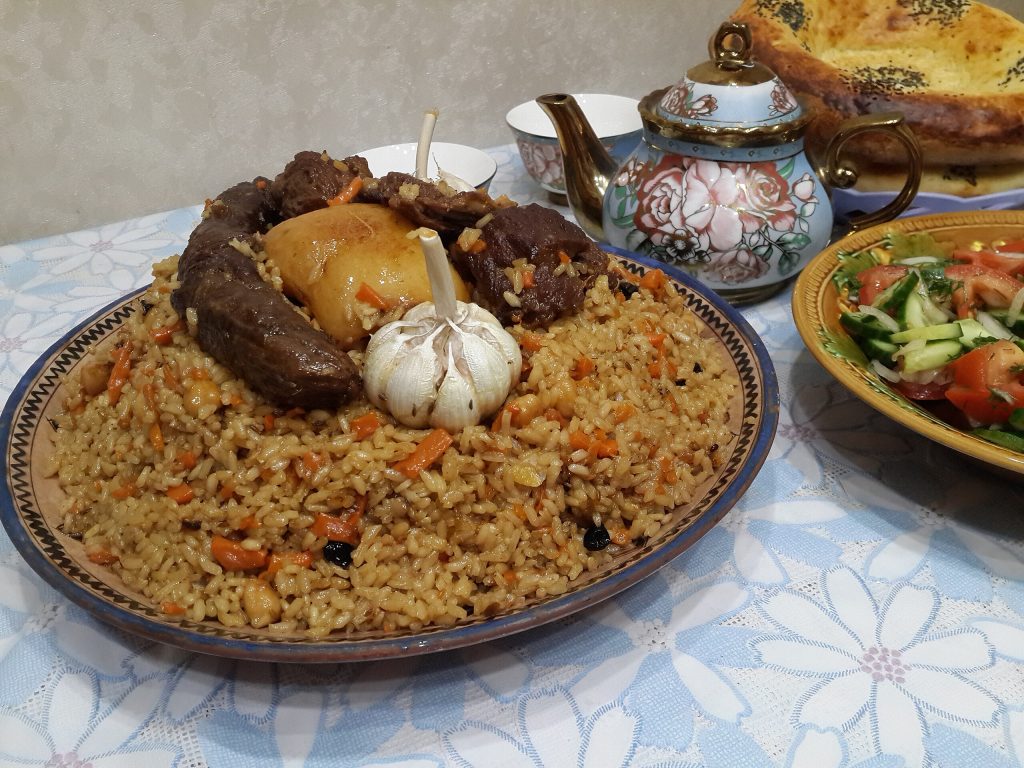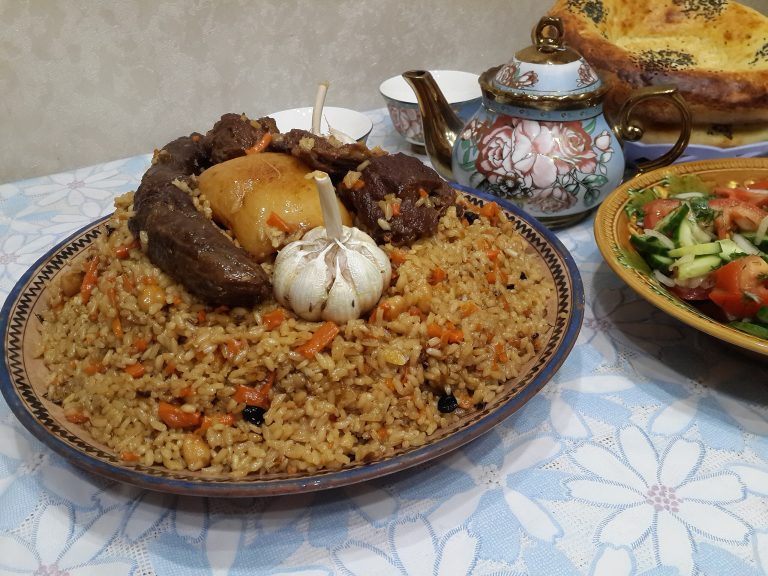I remember being a child in communist Romania in the 1980s Pilaf It was a staple in the Ottoman-influenced cuisine of the south of the country. My mother and grandmother would put it in the oven, after boiling the rice for a short time on the stove. It's made with chicken (from the countryside, of course, as it was unheard of on store shelves during the economic crisis of the 1980s), mushrooms (when available), or even with nothing (since “nothing” was pretty much available). In the 1980s, unlike chicken or mushrooms). Pilaf It was – and still is – an easy-to-make, affordable and filling dish.
At that time, we had no idea about the origins Pilaf, nor other staples of Romanian cuisine, as no one was interested in laying out what we could (and especially couldn't) eat under the Ceaușescu regime. Moreover, in an autonomous country, as communist Romania was, how could we have known that Greek or Turkish children were fed largely the same foods? Pilaf By their mothers and grandmothers?
Years later, when faced with this reality, I was enraged to think that Greek and Turkish mothers and grandmothers had stolen the recipe for such an emblematic Roman dish. Then I started digging into its history.
Often, it is difficult to explain why and how a particular dish has remained in a community's memory, while others have not. Good, Pilaf It has survived in Romania and southeastern Europe, along with many other dishes of Ottoman origin, perhaps due to cheap and affordable main ingredients (rice and vegetables) and basic cooking techniques.

Russian pilaf. Photo: TOP TV 2019. Source: Wikimedia Commons
Origins Pilaf It can (arguably) be traced back to Alexander the Great, and even to East Turkestan, the homeland of the Uyghur people. In his book Cumin, camels and caravans: the saga of spices (University of California Press, 2014), Gary Paul Nabhan writes:
In the 4th century BC, Alexander the Great and his forces became drawn to Bactrian and Sogdian Pilaf They are said to have taken the preparations with them from the Sogdian capital of Markanda (present-day Samarkand) to Macedonia. But the first detailed description of how to prepare A Pilaf It came to us properly during the 10th century from Ibn Sina, known in the Western world as Avicenna. Because of his enormous influence, many consider Ibn Sina to be the father of hadith Pilaf Preparations.
Pilaf It has several (related) names depending on the region or country: column In Central Asia, it is widespread everywhere, from East Turkestan (present-day Xinjiang) to all five countries: Kazakhstan, Kyrgyzstan, Tajikistan, Turkmenistan, and Uzbekistan. The Russians call it Pilaf It was introduced throughout the Soviet Union, reaching the Baltic states, Belarus, and Ukraine.
On a website dedicated to Estonian cuisine, we can learn that, for example Pilaf He is
A foreign dish that over the years has become more and more popular in Estonia to the point…that it is part of our national cuisine…Originally, it is a Middle Eastern/Central Asian dish that has made a long journey from south to north to our dinner tables. With some touches of local spices and ingredients, Pilaf It has become one of the most popular daily meals in Estonia. Estonians also love pork very much, which is one of the main Estonian ingredients Pilaf It is definitely pork.
And Lithuanians seem to like it too PilafAs stated on the Lithuanian food cooking website:
Who can refuse a bowl of steaming and delicious Pilaf? In Lithuania it can be difficult to find a Lithuanian person who is not interested Pilaf. despite of Pilaf It is especially popular in many Asian, Balkan and other neighboring countries, and Lithuania is no exception… (although it is neither Asia nor the Balkans). maybe Pilaf It adapts well to Lithuanian cuisine due to the simplicity of its preparation and because after eating the bowl you will feel full very quickly.
In Belarus and most of Ukraine, Pilaf They most likely arrived with the Soviets, but the story is very different in Romania and Moldova, just as it is in the Crimean peninsula in southeastern Ukraine (the former Crimean Khanate).
As vassals of the Ottoman Empire for over 400 years, vast amounts of Turkish customs have permeated the eastern and southern part of Romania, including culinary customs. The same pattern applies to Bulgaria, Greece, and the Western Balkan countries (Albania and the former Yugoslavia); As well as Georgia, Armenia and Azerbaijan.
Although it has the same origins as those spread throughout the former Soviet Union and almost the same cooking process, Pilaf They arrived in southeastern Europe several centuries earlier from the Baltic states, western and northern Ukraine or Belarus. Depending on the country/region/community, it can be prepared with or without pork: with pork by Christian communities; Without pork by Muslims. Poultry is also widely used (especially chicken) and there are also plenty of vegetarian versions.
In Romania, it is sometimes called Serbian pilaf It is usually cooked in the oven, unlike Central Asian versions, which are cooked only over an open fire (on the stove). As for ingredients, I don't ever remember my mother or grandmother using lamb, as they do in Central Asia.
During the 19th century, the principalities of Wallachia and Moldova moved towards Western Europe and away from the Ottoman Empire. A cultural revolution occurred, especially during the second half of the nineteenth century, when most Eastern customs were eliminated and replaced by Western customs. France became the sacred model to follow, and from then on, the sun rose from Paris, replacing the setting sun that had hitherto risen in Istanbul.
However, while the region was discovering its Latin roots, most of the everyday cuisine of ordinary people remained – and remains – firmly rooted in the Ottoman Empire. Although Romanians consider themselves part of the Latin family in terms of language and origins, they are much closer to Serbs, Bulgarians, Albanians or Greeks in terms of dietary habits. Different but similar to the Balkan people, Romanians do not necessarily realize how close they are to their neighbors when it comes to traditional dishes.
Transylvania, which was part of the Austro-Hungarian Empire until the end of World War I, was subject to the Ottoman Empire for only 100 years. As a result, the influence of Ottoman customs did not have such a great influence here. Pilaf They most likely arrived in Transylvania via Romanian residents – this is mentioned in a 1928 cookbook (Anna Victor Lazar, Village housewife's kitchen. Nutritional tips and recipesSibiu, Astra Society Publishing House, Sibiu, 1928), when Transylvania had already become part of the Kingdom of Romania.
This basic dish also has other versions, somewhat different/close to the original Plow pilaf. In the Indian subcontinent, biryani The same principle is used to prepare rice with meat and/or vegetables. The main difference is that, while the “classic” versions of Plow pilaf Not very spicy, biryani It contains dozens of them, so that a raita You are welcome to serve the yogurt-based sauce with it, in order to cool down the heat of the chili peppers.
Kabul rice It is a famous dish in Afghanistan and Pakistan. It's garnished with carrots, raisins, almonds, pomegranate seeds, walnuts and pistachios, making you feel like you're stumbling across treasure in Ali Baba's cave. A similar decorated version exists in Iran as well, where some cookbooks call it it Jeweled rice (Michael Bateman, World of spicesKyle Books, London, 2004), although Iranians usually make it fairly simple – either boiled or oven-cooked.
Spanish Paella It is another version of the dish, which likely has its origins in Islamic Spain (Andalusia). The Moors introduced rice cultivation to the Iberian Peninsula around the 10th century, and by the 15th century rice had become a staple. Paella It can be made with meat, chicken, fish or seafood. Boil the ingredients with vegetables and saffron. The latter gives Paella Its distinctive orange color, which, with Al dente The texture of rice, can make us consider it a distant relative of rice Plow pilaf family.
If one were to map the expansion of… Pilaf From Central Asia to Europe, two main routes will emerge: the northern route through the Soviet Union; The southern route, which occurred centuries before the northern route, was via the Turkic peoples (mostly Seljuks and Ottomans). No matter the way, Pilaf It certainly belongs to the gastronomic heritage of all peoples who still love it to such an extent that in 2016 Uzbekistan included it in the UNESCO Representative List of the Intangible Cultural Heritage of Humanity.
A Romanian language version of this text can be read here.

